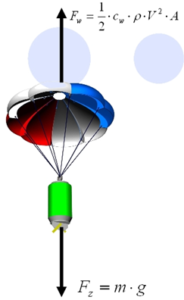Before we can start making the parachute we will have to figure out how big it should be. More specifically, we need to calculate how much surface area the parachute will need in order to fulfil the requirements.
Logic suggests that the bigger the parachute the slower the object’s descent velocity. Later on this principle is shown with some basic equations.
Although it would be very beneficial for the CanSat to have a very low descent rate, a limit has been set to ensure that the CanSat will land near the launch area. If the descent rate is too slow the CanSat may drift kilometres away along with the wind, which is neither allowed nor desired. For safety reasons there has also been set a maximum descent rate.
To design the parachute we’ll use some simple physics. We use a simplified model to estimate the area of the parachute, after which we can start on the construction.
During the descent two forces will be acting on the CanSat as illustrated in the figure to the right. Gravity will pull on the can and accelerate it towards the ground, and the drag force on the parachute will act on the CanSat in the opposite direction and slows down the descent rate. The two forces are shown in the figure to the right.
When the CanSat is deployed, the force of gravity will cause it to accelerate. The drag force depends on the velocity of the CanSat and when the velocity is low, the drag force is smaller that the force of gravity. When the velocity grows, the drag force becomes larger and after a few seconds the drag force from the parachute will reach equilibrium with the force of gravity. From that point on, the acceleration will be zero and the CanSat will descend at a constant velocity. This constant velocity has to be larger than the minimum descent velocity specified in the requirements. For the following calculations we can use this minimum value as the constant velocity of the CanSat.
The gravity force is equal to:
In this equation:
| Mass of the CanSat | |
| Acceleration of gravity, equal to |
The drag force of the parachute is equal to:
In this equation:
| Total area of the parachute (not just the frontal area) | |
| Drag coefficient of the parachute. This value depends on the shape of the parachute | |
| Local density of the air, assumed to be constant at | |
| Descent velocity of the CanSat |
When the acceleration is zero, the two forces are of equal size and we can write:
or
Given a desired velocity, you can easily rewrite this equation to calculate the area needed for the parachute.

